TP-Link RE650 AC2600 Wi-Fi Range Extender review
The TP-Link RE650 AC2600 Wi-Fi Range Extender has the power to push a network into uncovered areas.
Why you can trust Tom's Guide

The TP-Link RE650 AC2600 Wi-Fi range extender is one of the biggest and most expensive of the plug-in extenders we've reviewed, but it delivers great power and speedy data across longer distances, making it the best Wi-Fi extender for even the largest home.
It is big for a plug-in unit and could block the use of neighboring outlets, but the only range extender offering better performance is the even larger, desktop-bound Netgear Nighthawk X6S EX8000 tri-band Wi-Fi extender. The TP-Link RE650 uses 802.11ac specs to retransmit a strong signal that works with most routers used in homes today, enlarging your router's reach.
Editor's Note: We periodically update our reviews to make sure that pricing and information is up to date. The rating and recommendations in our TP-Link RE650 AC2600 Wi-Fi Range Extender review is unchanged from when it originally published in June of 2018.
TP-Link RE650 AC2600 Wi-Fi Range Extender: Design
The RE650 has a three-prong plug in its back that goes right into an AC outlet, but at 6.3 x 3.0 x 1.8 inches, the white and gray extender is four times bigger than the Netgear EX6120 AC1200 Essentials Edition Wi-Fi range extender, which also has a plug-in design. In fact, TP-Link's device is so big that it can block nearby wall outlets.
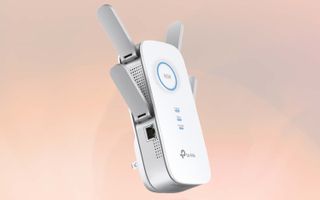
Its four LEDs serve as indicator lights for power as well as connections with the host router's 2.4- and 5-GHz networks. Near the top, a circular LED ring glows red when the device is too far from the router and blue when it's in its sweet spot. If this ends up looking like a light show, you can turn the LEDs off with a switch on the unit's side or schedule them to turn on and off.
The RE650 is so big that it can block nearby wall outlets.
The RE650 uses TP-Link's Intelligent Processing Engine to pick the most efficient path for the data to travel from router to extender to client. Unlike the Netgear Nighthawk X6S EX8000 tri-band Wi-Fi extender, the RE650 does this transfer without a dedicated data channel. It moves data on four lanes of traffic and can theoretically deliver 1,733 Mbps over its 5-GHz channel and 800 Mbps over the 2.4-GHz channel for an AC2600 bandwidth rating.

In our mock home network, the RE650 fell short of the Netgear X6S's ability to move data over 30 feet, through a wall and up a floor, delivering 153.1 Mbps for devices to use. This is less than half of the X6S' 338.5 Mbps and well behind the Linksys RE7000's 219.5 Mbps, but it's in another class compared to the Coredy E300 Mini Wi-Fi range extender's mere 21.9 Mbps of available bandwidth. When two walls were added to the setup, the TP-Link's throughput dropped to 215.2 Mbps, about 100 Mbps less than the Netgear X6S' result (316.8 Mbps), but on a par with the Linksys RE7000's production. (Older products, like the one seen in our Super Boost Wireless-N Wi-Fi Repeater review, fared far worse, so it's always worth getting devices that use more current standards.)
RE650 packs a lot of power and closely trailed the Netgear X6S in most of our tests.
At my home, the RE650 had a range of 75 feet, about half that of the Netgear X6S. It provided a massive 156 Mbps of bandwidth on an outdoor porch area that's 50 feet away. It easily played 4K videos and music on my iPad Pro. It ran for a full day without a problem, never got more than warm to the touch and used 5.4 watts of power.
TP-Link RE650 AC2600 Wi-Fi Range Extender: Features
Featuring beam-forming and MU-MIMO technologies to accommodate many connected devices at once, TP-Link rates the RE650 to fill 14,000 square feet. Inside the extender is an 880-MHz dual-core processor that controls the extender's operations and streamlines delivery of the data.
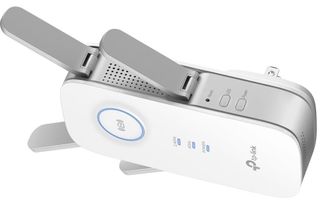
Rather than aimable antennas, the RE650 has four paddles that fold out 2.5 inches; one covers the Gigabit Ethernet connection. The extender does without a USB port.
In addition to a power switch, the RE650 has a switch for turning off the lights and a recessed reset button. The circular signal-strength indicator doubles as a switch for using WPS to quickly connect with a router or clients.
TP-Link RE650 AC2600 Wi-Fi Range Extender: Setup and software
TP-Link gives you the choice of using WPS or a browser-based procedure to connect to the host router. I chose the latter and plugged the RE650 into an AC outlet near to the host router. After I connected to its unsecured network (TP-LINK_EXTENDER_2.4GHz) with my iPad Pro and typed, "tplinkrepeater.net" into the web browser's address bar, the extender's setup routine took over.
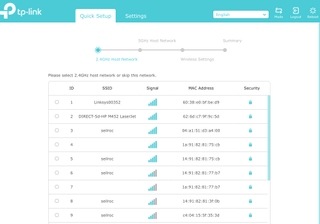
After picking the networks I wanted to extend, I entered their passcodes and then the name and passcode of the extended network. Following a restart, the extender was online.
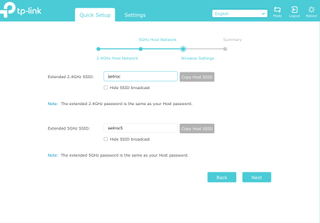
With the basics done, I unplugged and moved the RE650 about 50 feet away and plugged it in near to where I wanted the Wi-Fi signal to end up. In about a minute, the signal strength meter glowed blue and the RE650 pushed Wi-Fi connectivity to the extremes of my home.
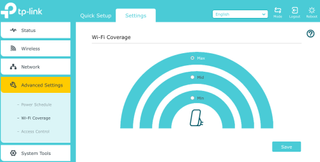
The RE650's interface can do things that others can't, like power the extender on and off to a schedule and adjust its signal strength. My favorite is being able to have the extender turn off its LEDs at night.
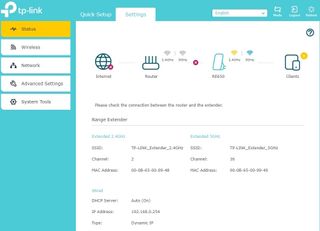
TP-Link's Tether app (available for iOS and Android) lets you monitor the extender's operations from a phone or tablet. It let me change the network name and security passcodes and schedule online access for little ones.
TP-Link RE650 AC2600 Wi-Fi Range Extender: Warranty and support
Rather than a one-year warranty, TP-Link stands by its device with two years of coverage, twice as long as the others. The warranty includes 24/7 support, something that Netgear cuts off after 90 days.
TP-Link's site has everything from videos and firmware downloads to troubleshooting help, plus one nice extra: a software emulator. This shows what the configuration software looks like, so newbies can familiarize themselves with the device's ins and outs before doing anything potentially harmful.
TP-Link RE650 AC2600 Wi-Fi Range Extender: Verdict
It may deliver good throughput and range, while the company's Tether app can keep an eye on the device, but the $125 TP-Link RE650 AC2600 Wi-Fi range extender is expensive and so big that it can block an adjacent outlet. Still, it was the top-performing plug-in extender, and it blows away the Linksys RE7000 in all categories except price.
Sign up to get the BEST of Tom's Guide direct to your inbox.
Here at Tom’s Guide our expert editors are committed to bringing you the best news, reviews and guides to help you stay informed and ahead of the curve!
Brian Nadel is a freelance writer and editor who specializes in technology reporting and reviewing. He works out of the suburban New York City area and has covered topics from nuclear power plants and Wi-Fi routers to cars and tablets. The former editor-in-chief of Mobile Computing and Communications, Nadel is the recipient of the TransPacific Writing Award.
